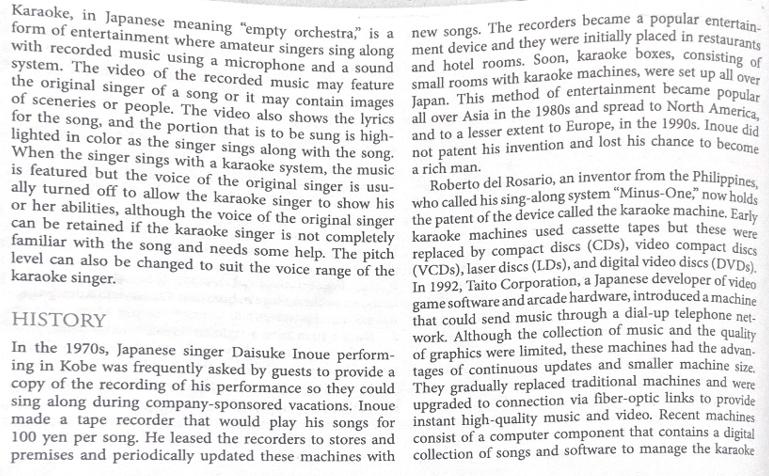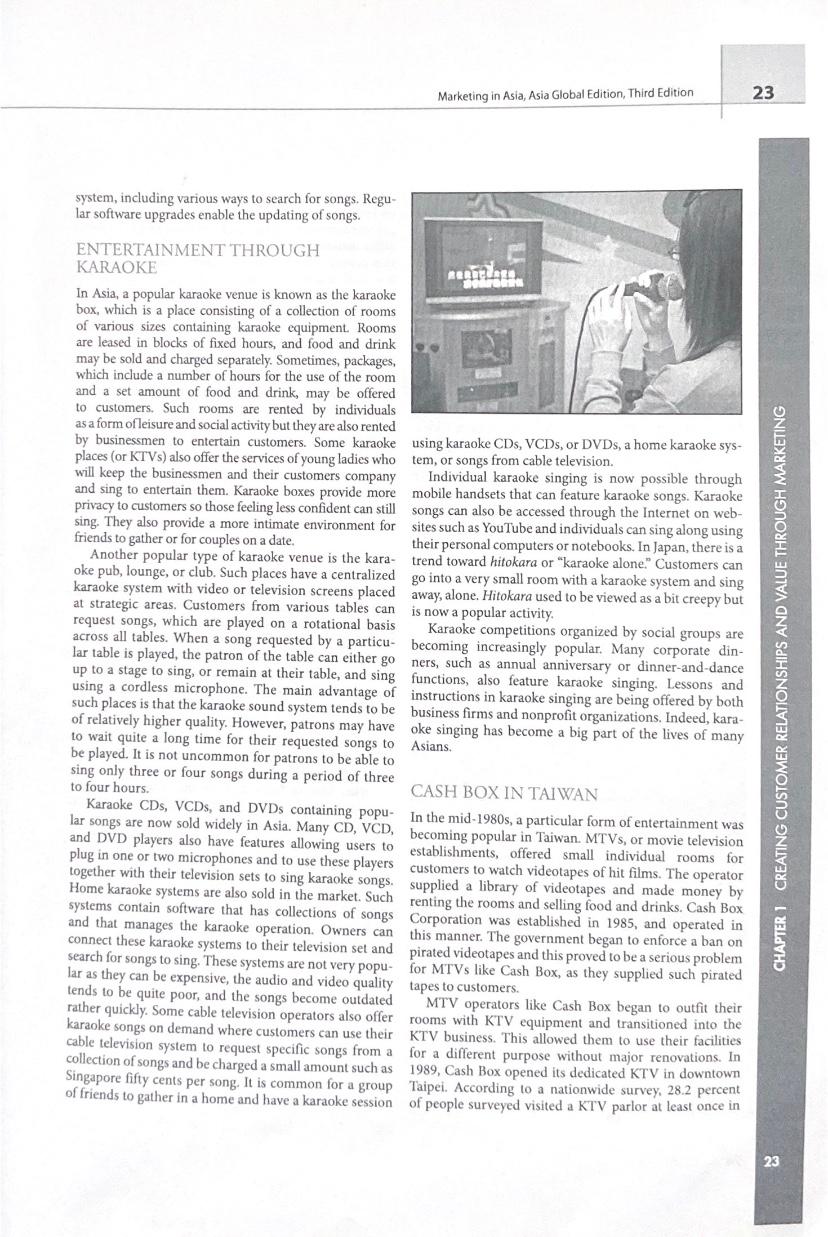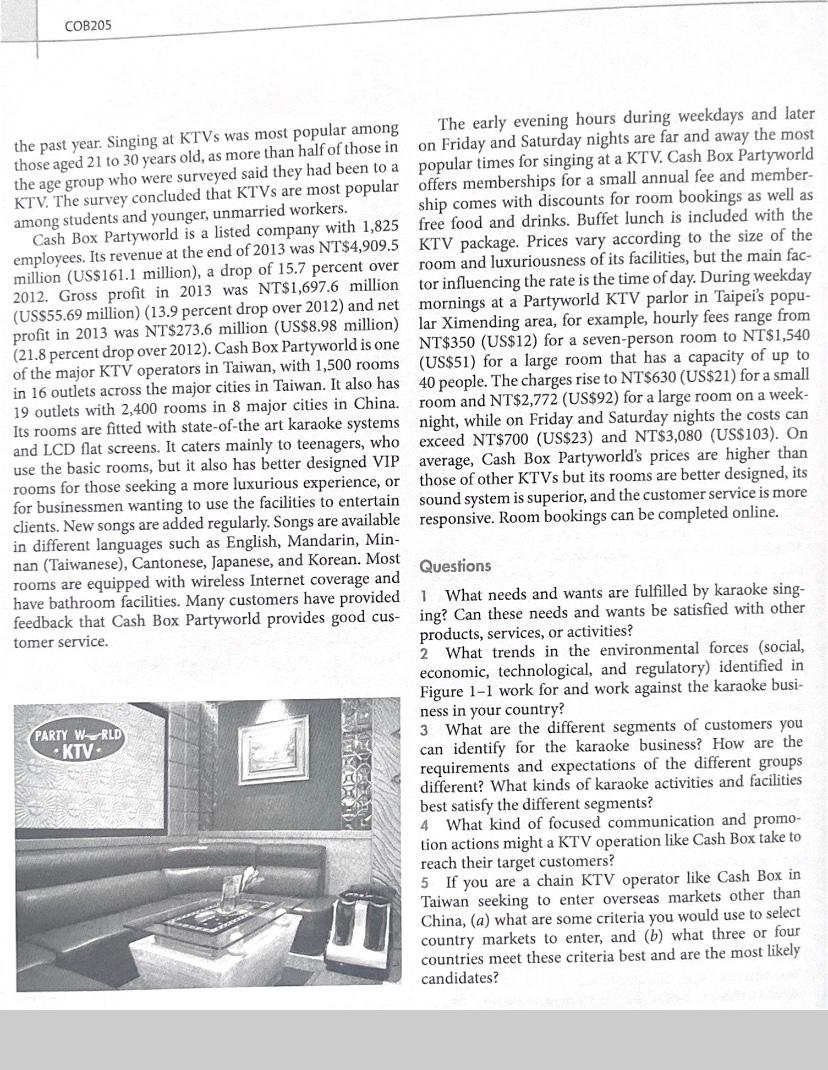Answered step by step
Verified Expert Solution
Question
1 Approved Answer
Karaoke, in Japanese meaning empty orchestra, is a form of entertainment where amateur singers sing along ment device and they were initially placed in



Karaoke, in Japanese meaning "empty orchestra," is a form of entertainment where amateur singers sing along ment device and they were initially placed in restaurants with recorded music using a microphone and a sound and hotel rooms. Soon, karaoke boxes, consisting of new songs. The recorders became a popular entertain- the original singer of a song or it may contain images Japan. This method of entertainment became popular system. The video of the recorded music may feature small rooms with karaoke machines, were set up all over of sceneries or people. The video also shows the lyrics all over Asia in the 1980s and spread to North America, for the song, and the portion that is to be sung is high- and to a lesser extent to Europe, in the 1990s. Inoue did lighted in color as the singer sings along with the song. not patent his invention and lost his chance to become When the singer sings with a karaoke system, the music a rich man. is featured but the voice of the original singer is usu- ally turned off to allow the karaoke singer to show his who called his sing-along system "Minus-One," now holds Roberto del Rosario, an inventor from the Philippines, or her abilities, although the voice of the original singer the patent of the device called the karaoke machine, Early can be retained if the karaoke singer is not completely karaoke machines used cassette tapes but these were familiar with the song and needs some help. The pitch replaced by compact discs (CDs), video compact discs level can also be changed to suit the voice range of the (VCDs), laser discs (LDs), and digital video discs (DVDs). karaoke singer. In 1992, Taito Corporation, a Japanese developer of video game software and arcade hardware, introduced a machine that could send music through a dial-up telephone net- work. Although the collection of music and the quality of graphics were limited, these machines had the advan- tages of continuous updates and smaller machine size. They gradually replaced traditional machines and were upgraded to connection via fiber-optic links to provide instant high-quality music and video. Recent machines consist of a computer component that contains a digital collection of songs and software to manage the karaoke HISTORY In the 1970s, Japanese singer Daisuke Inoue perform- ing in Kobe was frequently asked by guests to provide a copy of the recording of his performance so they could sing along during company-sponsored vacations. Inoue made a tape recorder that would play his songs for 100 yen per song. He leased the recorders to stores and premises and periodically updated these machines with system, including various ways to search for songs. Regu- lar software upgrades enable the updating of songs. ENTERTAINMENT THROUGH KARAOKE In Asia, a popular karaoke venue is known as the karaoke box, which is a place consisting of a collection of rooms of various sizes containing karaoke equipment. Rooms are leased in blocks of fixed hours, and food and drink may be sold and charged separately. Sometimes, packages, which include a number of hours for the use of the room. and a set amount of food and drink, may be offered to customers. Such rooms are rented by individuals as a form of leisure and social activity but they are also rented by businessmen to entertain customers. Some karaoke places (or KTVs) also offer the services of young ladies who will keep the businessmen and their customers company. and sing to entertain them. Karaoke boxes provide more privacy to customers so those feeling less confident can still sing. They also provide a more intimate environment for friends to gather or for couples on a date. Another popular type of karaoke venue is the kara- oke pub, lounge, or club. Such places have a centralized karaoke system with video or television screens placed at strategic areas. Customers from various tables can request songs, which are played on a rotational basis across all tables. When song requested by a particu- lar table is played, the patron of the table can either go up to a stage to sing, or remain at their table, and sing using a cordless microphone. The main advantage of such places is that the karaoke sound system tends to be of relatively higher quality. However, patrons may have to wait quite a long time for their requested songs to be played. It is not uncommon for patrons to be able to sing only three or four songs during a period of three to four hours. Karaoke CDs, VCDs, and DVDs containing popu- lar songs are now sold widely in Asia. Many CD, VCD, and DVD players also have features allowing users to plug in one or two microphones and to use these players together with their evision sets to sing karaoke songs. Home karaoke systems are also sold in the market. Such systems contain software that has collections of songs and that manages the karaoke operation. Owners can connect these karaoke systems to their television set and search for songs to sing. These systems are not very popu- lar as they can be expensive, the audio and video quality tends to be quite poor, and the songs become outdated rather quickly. Some cable television operators also offer karaoke songs on demand where customers can use their cable television system to request specific songs from a collection of songs and be charged a small amount such as Singapore fifty cents per song. It is common for a group of friends to gather in a home and have a karaoke session Marketing in Asia, Asia Global Edition, Third Edition REGTELE BEAFBEEN using karaoke CDs, VCDs, or DVDs, a home karaoke sys- from cable television. tem, or Individual karaoke singing is now possible through mobile handsets that can feature karaoke songs. Karaoke songs can also be accessed through the Internet on web- sites such as YouTube and individuals can sing along using their personal computers or notebooks. In Japan, there is trend toward hitokara or "karaoke alone." Customers can go into a very small room with a karaoke system and sing away, alone. Hitokara used to be viewed as a bit creepy but is now a popular activity. Karaoke competitions organized by social groups are becoming increasingly popular. Many corporate din- functions, also feature karaoke singing. Lessons and ners, such as annual anniversary or dinner-and-dance instructions in karaoke singing are being offered by both business firms and nonprofit organizations. Indeed, kara- oke singing has become a big part of the lives of many Asians. CASH BOX IN TAIWAN e operator In the mid-1980s, a particular form of entertainment was becoming popular in Taiwan. MTVs, or movie television establishments, offered small individual rooms for customers to watch videotapes of hit films. supplied a library of videotapes and made money by renting the rooms and selling food and drinks. Cash Box Corporation was established in 1985, and operated in pirated videotapes and this proved to be a serious problem this manner. The government began to enforce a ban on tapes to customers. for MTVs like Cash Box, as they supplied such pirated rooms with KTV equipment and transitioned into the MTV operators like Cash Box began to outfit their KTV business. This allowed them to use their facilities for a different purpose without major renovations. In 1989, Cash Box opened its dedicated KTV in downtown Taipei. According to a nationwide survey, 28.2 percent of people surveyed visited a KTV parlor at least once in 23 CHAPTER 1 CREATING CUSTOMER RELATIONSHIPS AND VALUE THROUGH MARKETING 23 COB205 the past year. Singing at KTVs was most popular among those aged 21 to 30 years old, as more than half of those in the age group who were surveyed said they had been to a KTV. The survey concluded that KTVs are most popular among students and younger, unmarried workers. Cash Box Partyworld is a listed company with 1,825 employees. Its revenue at the end of 2013 was NT$4,909.5 million (US$161.1 million), a drop of 15.7 percent over 2012. Gross profit in 2013 was NT$1,697.6 million (US$55.69 million) (13.9 percent drop over 2012) and net profit in 2013 was NT$273.6 million (US$8.98 million) (21.8 percent drop over 2012). Cash Box Partyworld is one of the major KTV operators in Taiwan, with 1,500 rooms in 16 outlets across the major cities in Taiwan. It also has 19 outlets with 2,400 rooms in 8 major cities in China. Its rooms are fitted with state-of-the art karaoke systems and LCD flat screens. It caters mainly to teenagers, who use the basic rooms, but it also has better designed VIP rooms for those seeking a more luxurious experience, or for businessmen wanting to use the facilities to entertain clients. New songs are added regularly. Songs are available in different languages such as English, Mandarin, Min- nan (Taiwanese), Cantonese, Japanese, and Korean. Most rooms are equipped with wireless Internet coverage and have bathroom facilities. Many customers have provided feedback that Cash Box Partyworld provides good cus- tomer service. PARTY WRLD KTV The early evening hours during weekdays and later on Friday and Saturday nights are far and away the most popular times for singing at a KTV. Cash Box Partyworld offers memberships for a small annual fee and member- ship comes with discounts for room bookings as well as free food and drinks. Buffet lunch is included with the KTV package. Prices vary according to the size of the room and luxuriousness of its facilities, but the main fac- tor influencing the rate is the time of day. During weekday mornings at a Partyworld KTV parlor in Taipei's popu- lar Ximending area, for example, hourly fees range from NT$350 (US$12) for a seven-person room to NT$1,540 (US$51) for a large room that has a capacity of up to 40 people. The charges rise to NT$630 (US$21) for a small room and NT$2,772 (US$92) for a large room on a week- night, while on Friday and Saturday nights the costs can exceed NT$700 (US$23) and NT$3,080 (US$103). On average, Cash Box Partyworld's prices are higher than those of other KTVs but its rooms are better designed, its sound system is superior, and the customer service is more responsive. Room bookings can be completed online. Questions 1 What needs and wants are fulfilled by karaoke sing- ing? Can these needs and wants be satisfied with other products, services, or activities? 2 What trends in the environmental forces (social, economic, technological, and regulatory) identified in Figure 1-1 work for and work against the karaoke busi- ness in your country? 3 What are the different segments of customers you. can identify for the karaoke business? How are the requirements and expectations of the different groups different? What kinds of karaoke activities and facilities best satisfy the different segments? 4 What kind of focused communication and promo- tion actions might a KTV operation like Cash Box take to reach their target customers? 5 If you are a chain KTV operator like Cash Box Taiwan seeking to enter overseas markets other than China, (a) what are some criteria you would use to select country markets to enter, and (b) what three or four countries meet these criteria best and are the most likely candidates?
Step by Step Solution
★★★★★
3.25 Rating (151 Votes )
There are 3 Steps involved in it
Step: 1

Get Instant Access to Expert-Tailored Solutions
See step-by-step solutions with expert insights and AI powered tools for academic success
Step: 2

Step: 3

Ace Your Homework with AI
Get the answers you need in no time with our AI-driven, step-by-step assistance
Get Started


